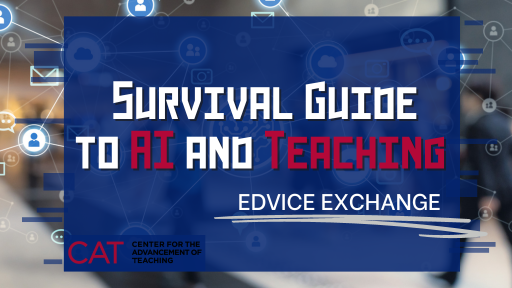Jennifer Zaylea and Jeff Rients

In the previous two blog posts of this series, we addressed ways in which you may decide to incorporate AI into your classroom. In this post, we offer suggestions for how you might creatively work outside the limits of AI by developing assignments and assessments that tools like ChatGPT cannot easily simulate.
Creating learning activities that prioritize human interaction (whether online or in-person), personal experience, and local knowledge can reduce the chance that your students will come to rely solely on AI-generative tools. This method has the benefit of prioritizing the humanity of the learning experience, because this method focuses student learning on the personal or community aspects of what we are teaching. It also can be more meaningful for students, motivating them to higher levels of effort.
Below are some possible assignments that are more difficult to simulate with generative AI tools. Remember, if you need assistance fleshing any of these ideas out or designing your own creative assignments, you can always schedule a one-on-one consultation with one of our staffers!
- Focus on human interactions in the form of attending events, arranging interviews, and conducting ethnographies of practitioners in your field. Ask for photos to be included as part of the student submission. Note: always include expectations for these kinds of activities up front in your syllabus, and keep in mind that it may be more difficult for some students to attend events and conduct in-person interviews because of work, transportation costs, etc. Having an alternative method for completing the assignment handy in case of particular student hardship would be wise.
- Design assignments that ask students to meaningfully incorporate breaking news, local events, or niche references–forms of data or knowledge that AI tools have not been extensively trained on. Analysis of an event as it is still unfolding not only makes it harder for AIs to respond, but they also provide students with a much needed sense of the real connection of what they are learning with the world.
- Require “process papers” with follow-up on incomplete/incorrect steps to be revisited for iterative projects. For example, require that the second draft of a paper (or the second paper of the semester) must be accompanied by a memo outlining how earlier feedback was incorporated into the new submission.
- Ask students to record their making process for studio-oriented projects. This could take the form of a series of still images or videos, accompanied with a written reflection on the overall creative process.
- Strive to account for non-Western points of view outside the reach of most current AI datasets. Your students may need to use Google Translate to get the jist of some non-English websites, perhaps comparing them to similar English-language sources. Or they could interview people with non-Western perspectives.
- Use presentations, oral exams, classroom debates, and in-class writing activities to explore knowledge without immediate recourse to AI tools. Look for ways to connect these in-class activities to assignments outside of class, such as asking students to write a paper analyzing and evaluating a classroom debate.
- Consider using collaborative tools that allow for tracking of specific student contributions, such as Google Docs, Dropbox Paper, or Microsoft Word. A look at the edit history of the Google Doc for a collaborative project would allow you to see who was writing and who was revising the group paper.
- Utilize alternative assessments beyond high-stakes essays, such as group concept maps, gamification-based activities, or student podcasts.
- Assign multi-media composition work currently beyond AI capabilities, such as creating a zine that incorporates both words and images to document learning or designing a board game or card game that illustrates key course concepts in action.
- Ask students who are doing coding revisions, such as coding for graphic design, animation, computer programming, or websites to screen record their corrections while explaining why they made changes. The assignment will encourage students to clearly articulate what the actions are accomplishing while reinforcing the skills they have learned.
- Have students write reflectively on how their past personal experiences intersect with their current learning.
Familiarity with a few of these approaches can also be helpful in the event that your otherwise AI-intensive course is disrupted by website crashes, fee structure changes, government regulation, or potential bans. A mix-and-match approach may best fit your learning environment, regardless. You may want one unit to focus on using AI tools and another that eschews them completely.
Just as with other teaching decisions (think absence or late work policies), your policies on the use of AI to complete work in your course will be a decision that you will have to make. As we’ve mentioned in earlier posts in this series, it will be important to include a statement on your syllabus, which you should discuss during your first class, that explains your policies so that students understand clearly the expectations for your course, and so that the Office of Student Conduct has a standard by which to make decisions about any cases of academic misconduct. The CAT has developed sample syllabus statements that provide language you can adopt for your own use.
In the next installment of our series, we’ll look at how to foster students’ digital literacy skills in the age of generative AI.
Jennifer Zaylea and Jeff Rients both work at Temple’s Center for the Advancement of Teaching, where Jennifer serves as the Digital Media Specialist and Jeff Rients serves as Associate Director of Teaching & Learning Innovation.